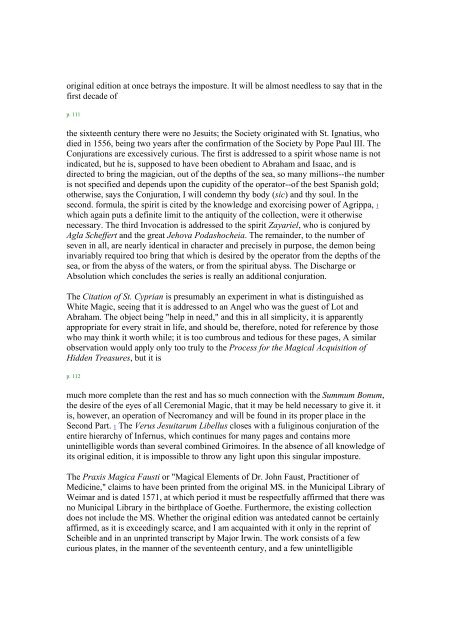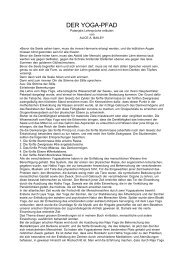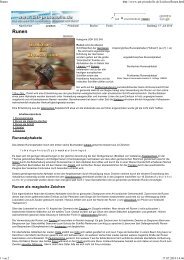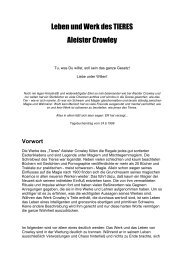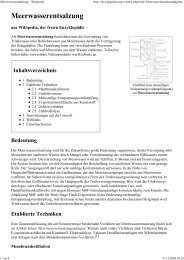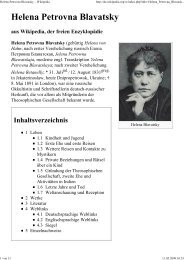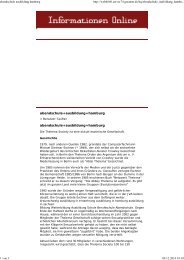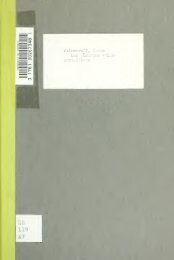The Book of ceremonial Magic
The Book of ceremonial Magic
The Book of ceremonial Magic
Create successful ePaper yourself
Turn your PDF publications into a flip-book with our unique Google optimized e-Paper software.
original edition at once betrays the imposture. It will be almost needless to say that in the<br />
first decade <strong>of</strong><br />
p. 111<br />
the sixteenth century there were no Jesuits; the Society originated with St. Ignatius, who<br />
died in 1556, being two years after the confirmation <strong>of</strong> the Society by Pope Paul III. <strong>The</strong><br />
Conjurations are excessively curious. <strong>The</strong> first is addressed to a spirit whose name is not<br />
indicated, but he is, supposed to have been obedient to Abraham and Isaac, and is<br />
directed to bring the magician, out <strong>of</strong> the depths <strong>of</strong> the sea, so many millions--the number<br />
is not specified and depends upon the cupidity <strong>of</strong> the operator--<strong>of</strong> the best Spanish gold;<br />
otherwise, says the Conjuration, I will condemn thy body (sic) and thy soul. In the<br />
second. formula, the spirit is cited by the knowledge and exorcising power <strong>of</strong> Agrippa, 1<br />
which again puts a definite limit to the antiquity <strong>of</strong> the collection, were it otherwise<br />
necessary. <strong>The</strong> third Invocation is addressed to the spirit Zayariel, who is conjured by<br />
Agla Scheffert and the great Jehova Podashocheia. <strong>The</strong> remainder, to the number <strong>of</strong><br />
seven in all, are nearly identical in character and precisely in purpose, the demon being<br />
invariably required too bring that which is desired by the operator from the depths <strong>of</strong> the<br />
sea, or from the abyss <strong>of</strong> the waters, or from the spiritual abyss. <strong>The</strong> Discharge or<br />
Absolution which concludes the series is really an additional conjuration.<br />
<strong>The</strong> Citation <strong>of</strong> St. Cyprian is presumably an experiment in what is distinguished as<br />
White <strong>Magic</strong>, seeing that it is addressed to an Angel who was the guest <strong>of</strong> Lot and<br />
Abraham. <strong>The</strong> object being "help in need," and this in all simplicity, it is apparently<br />
appropriate for every strait in life, and should be, therefore, noted for reference by those<br />
who may think it worth while; it is too cumbrous and tedious for these pages, A similar<br />
observation would apply only too truly to the Process for the <strong>Magic</strong>al Acquisition <strong>of</strong><br />
Hidden Treasures, but it is<br />
p. 112<br />
much more complete than the rest and has so much connection with the Summum Bonum,<br />
the desire <strong>of</strong> the eyes <strong>of</strong> all Ceremonial <strong>Magic</strong>, that it may be held necessary to give it. it<br />
is, however, an operation <strong>of</strong> Necromancy and will be found in its proper place in the<br />
Second Part. 1 <strong>The</strong> Verus Jesuitarum Libellus closes with a fuliginous conjuration <strong>of</strong> the<br />
entire hierarchy <strong>of</strong> Infernus, which continues for many pages and contains more<br />
unintelligible words than several combined Grimoires. In the absence <strong>of</strong> all knowledge <strong>of</strong><br />
its original edition, it is impossible to throw any light upon this singular imposture.<br />
<strong>The</strong> Praxis <strong>Magic</strong>a Fausti or "<strong>Magic</strong>al Elements <strong>of</strong> Dr. John Faust, Practitioner <strong>of</strong><br />
Medicine," claims to have been printed from the original MS. in the Municipal Library <strong>of</strong><br />
Weimar and is dated 1571, at which period it must be respectfully affirmed that there was<br />
no Municipal Library in the birthplace <strong>of</strong> Goethe. Furthermore, the existing collection<br />
does not include the MS. Whether the original edition was antedated cannot be certainly<br />
affirmed, as it is exceedingly scarce, and I am acquainted with it only in the reprint <strong>of</strong><br />
Scheible and in an unprinted transcript by Major Irwin. <strong>The</strong> work consists <strong>of</strong> a few<br />
curious plates, in the manner <strong>of</strong> the seventeenth century, and a few unintelligible


